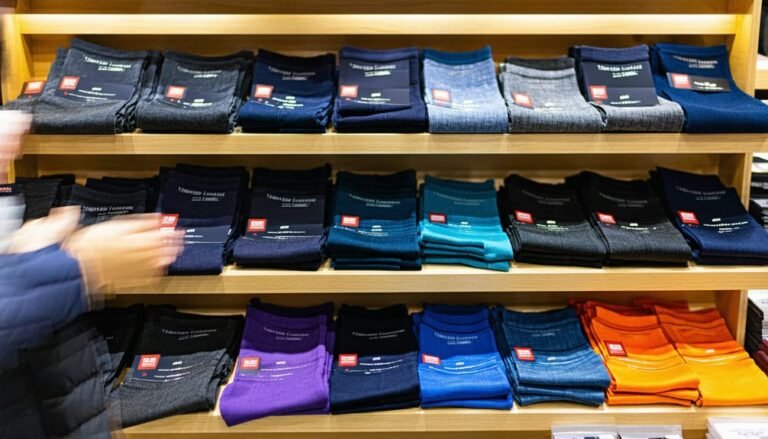Black Socks Vs White Socks
Choosing between black and white socks depends on your style priorities and the occasion. Black socks are versatile and lend sophistication, ideal for formal settings or when seeking practicality and elegance due to their stain-resistant nature. In contrast, white socks are a casual staple, perfect for relaxed or retro-influenced styles, emphasizing simplicity and a youthful vibe. Understanding historical and cultural influences on sock colors can guide you in making a fashion-forward decision. Explore further to enhance your selection skills.
Historical Evolution of Sock Colors

Though often overlooked, the color of socks has mirrored broader cultural and fashion trends throughout history. Originally, sock color origins were dictated by necessity and available materials. Natural fibers often resulted in muted tones, providing a practical, subtle appearance. As dyeing techniques advanced, the fashion industry influence grew, allowing for a vibrant array of hues that catered to evolving societal norms and personal expression. You might find it fascinating how sock colors shifted alongside fashion revolutions, reflecting the era's aesthetic priorities. This evolution wasn't just about style; it was also about safety and comfort. Bright colors were sometimes used to signal status or affiliation, while darker tones offered practicality. Understanding this evolution helps you appreciate how sock colors remain a statement in today's fashion landscape.
Black Socks: The Versatile Choice
Black socks have emerged as a staple in modern wardrobes, embodying versatility and timeless elegance. You'll find they seamlessly blend with both casual and formal attire, making them a go-to for many. Their fashion versatility lies in their ability to complement a wide range of colors and styles, ensuring you're always dressed appropriately. For those prioritizing everyday practicality, black socks offer a safe choice that resists visible stains and wear, maintaining a polished look.
Consider these benefits:
| Benefit | Description |
|---|---|
| Fashion Versatility | Complements various outfits |
| Everyday Practicality | Hides stains, ensuring longevity |
| Timeless Elegance | Suitable for formal and casual settings |
| Safety in Style | Provides a secure and polished appearance |
Ultimately, black socks are an investment in style and practicality, ensuring your wardrobe remains both functional and fashionable.
White Socks: The Casual Staple
In recent years, white socks have solidified their status as a beloved casual staple, a demonstration of their enduring appeal and adaptability. You'll notice that white sock trends have evolved, yet they consistently maintain their place in everyday wardrobes. Whether paired with sneakers or loafers, they offer a clean, fresh look that's easy to style. White sock styling is all about versatility—ideal for a laid-back vibe or a touch of retro charm.
When you choose white socks, you're opting for a safe, classic choice that complements diverse outfits. They project a sense of simplicity and reliability, offering comfort without compromising style. As fashion cycles evolve, white socks remain a constant, proving their indispensable role in casual wear.
Cultural Perspectives on Sock Colors
When considering cultural perspectives on sock colors, you'll find that historical trends have greatly influenced how we perceive black and white socks today. Black socks have often symbolized formality and sophistication, while white socks are frequently associated with casual and athletic settings. Understanding these nuances can help you appreciate how sock colors communicate different social cues and values across various cultures.
Historical Sock Color Trends
Though sock color might seem mundane, its history is quite revealing, reflecting broader cultural shifts and societal norms over time. Sock dyeing techniques have evolved considerably, mirroring advances in textile technology. In earlier times, colors like black were favored for their practicality, concealing dirt and wear. White socks gained prominence in the 20th century, aligning with the rise of casual, athletic fashion cycles. Each shift in sock color trends tells a story of societal needs and preferences. For instance, the Victorian era's preference for darker socks was linked to formal dress codes and the limited dye options. Today, the color of your socks can still signify adherence to or deviation from established norms, offering a glimpse into cultural evolution and personal expression.
Sock Colors and Symbolism
Sock colors have transcended their functional origins, evolving into potent symbols that communicate cultural values and personal identity. In sock psychology, black socks are often seen as markers of formality and professionalism, embodying a symbolism significance that aligns with authority and stability, appealing to those who prioritize safety in fashion choices. On the other hand, white socks, traditionally associated with purity and simplicity, have found their place in casual, everyday wear, reflecting a laid-back lifestyle. This trend indicates a broader cultural shift towards blending comfort with style. Understanding these symbolic meanings allows you to make informed choices that align with your personal values and societal expectations, ensuring that your sock selection resonates with the image you wish to project.
Style and Occasion: Choosing the Right Socks
How often have you pondered the impact of your sock choice on your overall ensemble? It's more significant than you might think. Sock color psychology suggests that black socks convey professionalism and sophistication, making them ideal for formal occasions. On the other hand, white socks often align with a casual, youthful vibe, perfect for laid-back settings or sports activities.
Current fashion trends emphasize the importance of matching socks to the occasion. In a world where first impressions matter, choosing the appropriate sock color can project safety and confidence. Black socks are your go-to for business meetings or elegant dinners, while white socks offer comfort and a relaxed aesthetic during informal gatherings. By understanding these nuances, you guarantee your outfit is always polished and appropriate.
Sock Material and Comfort Considerations
While selecting the right sock color for the occasion speaks volumes, don't overlook the importance of material and comfort. Cotton socks offer unparalleled breathability, making them ideal for those safety-conscious individuals who value foot hygiene and comfort. This natural fiber wicks moisture, reducing the risk of fungal infections and keeping your feet feeling fresh throughout the day. On the other hand, wool provides superb insulation, perfect for colder months when warmth is a priority. Wool's natural properties guarantee your feet remain snug while also allowing breathability. When choosing between black or white socks, consider the functional benefits of these materials. Whether you're aiming for cotton's airy comfort or wool's cozy insulation, prioritize your foot health and safety alongside style choices.
Making a Statement: Personalizing Your Sock Choice

Ever wondered how a simple choice like sock color can become a powerful expression of your personal style? When you choose between black and white socks, you're not just making a mundane fashion decision; you're crafting your sock personality. Black socks often exude a sleek, professional vibe, ideal for settings where you want to project authority and safety. Conversely, white socks can convey a casual, fresh aura, suggesting an approachable, relaxed fashion expression.
Analyzing the latest trends, many find that contrasting sock colors with outfits creates a dynamic look. This choice can subtly alter perceptions, signaling creativity or discipline. Ultimately, your sock choice is a canvas for self-expression, blending style with the comfort of knowing you're making a statement that aligns with your personal values.
Frequently Asked Questions
How Do Black Socks Impact Foot Odor Compared to White Socks?
When pondering fabric's impact on foot odor, think of Homer's Odyssey of breathability and absorption. You'll find that choosing better fabrics for odor absorption and enhanced breathability guarantees your feet's safety, keeping them fresh and comfortable.
Are Black Socks More Prone to Fading Than White Socks?
You're wondering if colored socks are prone to fading. Black socks can fade faster than white ones due to dye quality. Focus on color retention trends and high-quality dyes to guarantee your socks maintain their original hue.
Do White Socks Show Stains More Easily Than Black Socks?
When considering stain visibility, white socks do show stains more easily compared to other colors. However, fabric durability can vary. It's crucial to choose high-quality materials to guarantee longevity and maintain a clean, safe appearance.
Is There a Significant Price Difference Between Black and White Socks?
When diving into a price comparison, you'd think you're exploring a chasm of difference. However, material quality often determines cost. Trends show both options are generally priced similarly, ensuring your wallet's safety while choosing comfort.
How Do Black and White Socks Affect Foot Temperature?
You're curious about foot temperature, right? Black socks might retain more heat due to color absorption, affecting thermal regulation. White socks, reflecting more light, could keep your feet cooler, potentially enhancing comfort and safety in warmer conditions.







